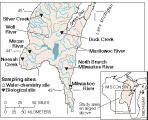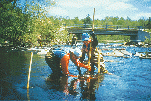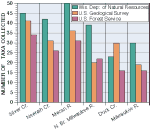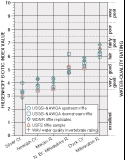Water Quality in the Western Lake Michigan Drainages, Wisconsin and Michigan, 1992-95
Table of contents || Previous section || Next section || Glossary
Control of water pollution became a major environmental priority during the last three decades, and in response, water-quality monitoring has expanded rapidly. Today, Federal, State and local water-resource management agencies make a considerable investment in the collection of water-quality information. A wide variety of procedures are used to collect this information, often depending upon the objectives of the collection effort. A lack of information regarding the quality and comparability of the data collected can result in duplicated sampling efforts or the underutilization of available water-quality information.
To address these concerns, studies were done to determine the comparability of water-chemistry and aquatic-invertebrate data collected by different methods in Wisconsin (Lenz and Miller, 1996; Wisconsin Department of Natural Resources and U.S. Geological Survey, 1994).
 (12,351 bytes)
(12,351 bytes)
Aquatic-biology method comparisons were done at six sites and water-chemistry method comparisons at three sites in the study area.
These studies were coordinated with the Wisconsin Department of Natural Resources (WDNR), U.S. Forest Service (USFS), and a volunteer group, Water Action Volunteers (WAV), in conjunction with the Wisconsin Water Resources Coordination Project, a pilot program implementing the recommendations of the Intergovernmental Task Force on Monitoring Water Quality (ITFM).
During 1993 and 1994, a study was done to compare water-chemistry results obtained using methods of the USGS and the WDNR (Wisconsin Department of Natural Resources and U.S. Geological Survey, 1994). Water-chemistry samples were collected four times, twice during base flow conditions and twice during storm runoff conditions, at three streams of various size that were chosen to represent stream variability in the study area. Duplicate samples were collected at each location using each collection, processing, and preservation method for analyses at both the USGS National Water-Quality Laboratory and the Wisconsin State Laboratory of Hygiene.
Total phosphorus, dissolved chloride, and suspended solids (sediment) were the water-chemistry parameters studied. Total phosphorus was chosen as an indicator constituent for nutrient concentrations, and dissolved chloride was chosen as an indicator for dissolved major ion concentrations.
Dissolved chloride in samples collected using the two agencies' methods were similar during both high- and low-flow conditions. Results indicated that concentrations of total suspended solids and suspended sediment concentrations were significantly higher for samples collected by the equal-width increment (EWI) sample method than using the grab sample method during high-flow conditions. Surprisingly, total phosphorus concentrations also were similar for each collection method and flow condition. It had been anticipated that total phosphorus would more closely mimic the suspended solids (sediment) results during high-flow conditions. There were significant differences between laboratories for analyses of concentrations of total phosphorus and dissolved chloride.
In general, laboratory analytical differences were more important than sample-collection-method differences. Samples collected for phosphorus and chloride by the two methods were comparable when analyzed by the same laboratory.
|
Method tested |
Total phosphorus |
Dissolved chloride |
Suspended sediment (SS)/ |
|---|---|---|---|
|
Differences between |
No difference |
No difference |
Concentrations of both |
|
Within field-sampling |
No difference |
No difference |
SS concentrations |
|
Differences between |
No difference |
No difference |
No difference |
|
Differences between |
USGS concentrations |
USGS concentrations |
Not applicable |
Aquatic-macroinvertebrate sampling methods used by the USGS, WDNR, and the USFS at riffle areas of streams were compared at six streams of various sizes in the study area. A volunteer group, WAV, performed an in-field invertebrate water-quality rating at one of the streams.
 (136,231 bytes)
(136,231 bytes)
Aquatic-biology method comparisons were done at six sites and water-chemistry method comparisons at three sites in the study area.
Results of the study indicated that differences in field-collection methods resulted in assessments of different habitats and the collection of different total numbers and proportions of individual species, indicating that field-collection methods need to be considered when comparing macroinvertebrate data among agencies (Lenz and Miller, 1996). However, the sampling methods resulted in similar water-quality ratings using the Hilsenhoff Biotic Index (HBI) a common benthic invertebrate environmental-tolerance measure.
 (11,622 bytes)
(11,622 bytes)
Different invertebrate sampling techniques resulted in different numbers of species collected.
In another study, USGS and WDNR data bases describing benthic macroinvertebrate communities in streams in the study area were paired with water-chemistry data to determine whether the data bases predicted water-quality conditions similarly. On the basis of the limited paired data available, the two data bases were shown to predict water-quality similarly using HBI (Lenz, 1997). However, results also indicated that benthic invertebrate data collected at different seasons should not be combined when using the data for water-quality assessments.
 (12,389 bytes)
(12,389 bytes)
Hilsenhoff Biotic Index (HBI) of environmental tolerance results from the three agencies and a volunteer group predicted water quality similarly.
|
The Intergovernmental Task Force On Monitoring Water Quality (ITFM) was a national program designed to coordinate monitoring programs; define efficient roles for Federal, State, and local agencies; evaluate diverse descriptions of aquatic conditions and trends; and develop a national water-information network (Intergovernmental Task Force on Monitoring Water Quality, 1994). The National Water-Quality Assessment Monitoring Council was established in May 1997 as the permanent successor to the ITFM. |
U.S. Geological Survey Circular 1156
Table of contents || Previous section || Next section || Glossary
Suggested citation:
C. A. Peters, D. M. Robertson, D. A. Saad, D. J. Sullivan, B. C. Scudder, F. A. Fitzpatrick, K. D. Richards, J. S. Stewart, S. A. Fitzgerald, and B. N. Lenz, 1998, U.S. Geological Survey Circular 1156, on line at <URL: https://water.usgs.gov/pubs/circ1156>, updated June 11, 1998